NCERT Solutions for Exercise 6.6 Class 10 Maths Chapter 6 - Triangles
CBSE Class 10th Exam Date:01 Jan' 26 - 14 Feb' 26
NCERT Solutions For Class 10 Maths Chapter 6 Exercise 6.6
NCERT Solutions for Exercise 6.6 Class 10 Maths Chapter 6 Triangles are discussed here. These NCERT solutions are created by subject matter expert at Careers360 considering the latest syllabus and pattern of CBSE 2023-24. Class 10 maths ex 6.6 help us to understand how to apply all the concepts till now we have learned through all the exercises in the chapter. The notion of triangle similarity, criteria for triangle similarity, areas of similar triangles, and Pythagoras Theorem are covered in this exercise.
10th class Maths exercise 6.6 answers are designed as per the students demand covering comprehensive, step by step solutions of every problem. Practice these questions and answers to command the concepts, boost confidence and in depth understanding of concepts. Students can find all exercise together using the link provided below.
- Triangle Exercise 6.1
- Triangle Exercise 6.2
- Triangle Exercise 6.3
- Triangle Exercise 6.4
- Triangle Exercise 6.5
Triangles Class 10 Chapter 6 Exercise: 6.6
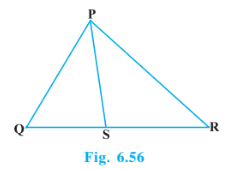
Answer:
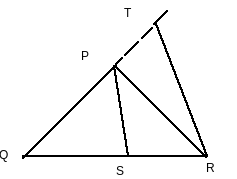
A line RT is drawn parallel to SP which intersect QP produced at T.
Given: PS is the bisector of $\angle QPR \: \: of\: \: \Delta PQR$ .
$\angle QPS=\angle SPR.....................................1$
By construction,
$\angle SPR=\angle PRT.....................................2$ (as PS||TR)
$\angle QPS=\angle QTR.....................................3$ (as PS||TR)
From the above equations, we get
$\angle PRT=\angle QTR$
$\therefore PT=PR$
By construction, PS||TR
In $\triangle$ QTR, by Thales theorem,
$\frac{QS}{SR}=\frac{QP}{PT}$
$\frac{QS }{SR } = \frac{PQ }{PR }$
Hence proved.
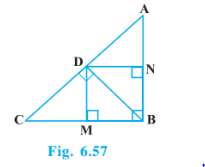
Answer:
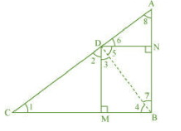
Join BD
Given : D is a point on hypotenuse AC of D ABC, such that BD $\perp$ AC, DM $\perp$ BC and DN $\perp$ AB.Also DN || BC, DM||NB
$\angle CDB=90 ^\circ$
$\Rightarrow \angle 2+\angle 3=90 ^\circ.............................1$
In $\triangle$ CDM, $\angle 1+\angle 2+\angle DMC=180 ^\circ$
$\angle 1+\angle 2=90 ^\circ.......................2$
In $\triangle$ DMB, $\angle 3+\angle 4+\angle DMB=180 ^\circ$
$\angle 3+\angle 4=90 ^\circ.......................3$
From equation 1 and 2, we get $\angle 1=\angle 3$
From equation 1 and 3, we get $\angle 2=\angle 4$
In $\triangle DCM\, \, and\, \, \triangle BDM,$
$\angle 1=\angle 3$
$\angle 2=\angle 4$
$\triangle DCM\, \, \sim \, \, \triangle BDM,$ (By AA)
$\Rightarrow \frac{BM}{DM}=\frac{DM}{MC}$
$\Rightarrow \frac{DN}{DM}=\frac{DM}{MC}$ (BM=DN)
$\Rightarrow$ $DM^2 = DN . MC$
Hence proved

Answer:
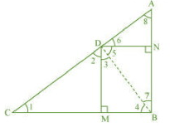
In $\triangle$ DBN,
$\angle 5+\angle 7=90 ^\circ.......................1$
In $\triangle$ DAN,
$\angle 6+\angle 8=90 ^\circ.......................2$
BD $\perp$ AC, $\therefore \angle ADB=90 ^\circ$
$\angle 5+\angle 6=90 ^\circ.......................3$
From equation 1 and 3, we get $\angle 6=\angle 7$
From equation 2 and 3, we get $\angle 5=\angle 8$
In $\triangle DNA\, \, and\, \, \triangle BND,$
$\angle 6=\angle 7$
$\angle 5=\angle 8$
$\triangle DNA\, \, \sim \, \, \triangle BND$ (By AA)
$\Rightarrow \frac{AN}{DN}=\frac{DN}{NB}$
$\Rightarrow \frac{AN}{DN}=\frac{DN}{DM}$ (NB=DM)
$\Rightarrow$ $DN^2 = AN . DM$
Hence proved.

Answer:
In $\triangle$ ADB, by Pythagoras theorem
$AB^2=AD^2+DB^2.......................1$
In $\triangle$ ACD, by Pythagoras theorem
$AC^2=AD^2+DC^2.......................2$
$AC^2=AD^2+(BD+BC)^2$
$\Rightarrow AC^2=AD^2+(BD)^2+(BC)^2+2.BD.BC$
$AC^2 = AB^2 + BC^2 + 2 BC . BD.$ (From 1)
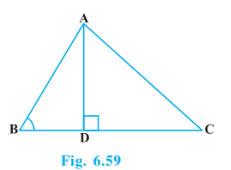
Answer:
In $\triangle$ ADB, by Pythagoras theorem
$AB^2=AD^2+DB^2$
$AD^2=AB^2-DB^2...........................1$
In $\triangle$ ACD, by Pythagoras theorem
$AC^2=AD^2+DC^2$
$AC^2=AB^2-BD^2+DC^2$ (From 1)
$\Rightarrow AC^2=AB^2-BD^2+(BC-BD)^2$
$\Rightarrow AC^2=AB^2-BD^2+(BC)^2+(BD)^2-2.BD.BC$
$AC^2 = AB^2 + BC^2 - 2 BC . BD.$
Q5 (1) In Fig. 6.60, AD is a median of a triangle ABC and AM $\perp$ BC. Prove that : $AC ^2 = AD ^2 + BC DM + \left ( \frac{BC}{2} \right ) ^2$

Answer:
Given: AD is a median of a triangle ABC and AM $\perp$ BC.
In $\triangle$ AMD, by Pythagoras theorem
$AD^2=AM^2+MD^2.......................1$
In $\triangle$ AMC, by Pythagoras theorem
$AC^2=AM^2+MC^2$
$AC^2=AM^2+(MD+DC)^2$
$\Rightarrow AC^2=AM^2+(MD)^2+(DC)^2+2.MD.DC$
$AC^2 = AD^2 + DC^2 + 2 DC . MD.$ (From 1)
$AC^2 = AD^2 + (\frac{BC}{2})^2 + 2(\frac{BC}{2}). MD.$ (BC=2 DC)
$AC ^2 = AD ^2 + BC DM + \left ( \frac{BC}{2} \right ) ^2$
Q5 (2) In Fig. 6.60, AD is a median of a triangle ABC and AM $\perp$ BC. Prove that : $AB ^2 = AD ^2 - BC .DM + \left ( \frac{BC}{2} \right ) ^2$

Answer:
In $\triangle$ ABM, by Pythagoras theorem
$AB^2=AM^2+MB^2$
$AB^2=(AD^2-DM^2)+MB^2$
$\Rightarrow AB^2=(AD^2-DM^2)+(BD-MD)^2$
$\Rightarrow AB^2=AD^2-DM^2+(BD)^2+(MD)^2-2.BD.MD$
$\Rightarrow AB^2=AD^2+(BD)^2-2.BD.MD$
$\Rightarrow AB^2 = AD^2 + (\frac{BC}{2})^2 -2(\frac{BC}{2}). MD.=AC^2$ (BC=2 BD)
$\Rightarrow AD^2 + (\frac{BC}{2})^2 -BC. MD.=AC^2$
Q5 (3) In Fig. 6.60, AD is a median of a triangle ABC and AM $\perp$ BC. Prove that: $AC ^2 + AB ^2 = 2 AD^2 + \frac{1}{2} BC ^2$
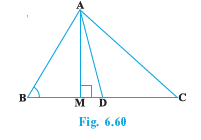
Answer:
In $\triangle$ ABM, by Pythagoras theorem
$AB^2=AM^2+MB^2.......................1$
In $\triangle$ AMC, by Pythagoras theorem
$AC^2=AM^2+MC^2$ ..................................2
Adding equation 1 and 2,
$AB^2+AC^2=2AM^2+MB^2+MC^2$
$\Rightarrow AB^2+AC^2=2AM^2+(BD-DM)^2+(MD+DC)^2$
$\Rightarrow AB^2+AC^2=2AM^2+(BD)^2+(DM)^2-2.BD.DM+(MD)^2+(DC)^2+2.MD.DC$
$\Rightarrow AB^2+AC^2=2AM^2+2.(DM)^2+BD^2+(DC)^2+2.MD.(DC-BD)$ $\Rightarrow AB^2+AC^2=2(AM^2+(DM)^2)+(\frac{BC}{2})^2+(\frac{BC}{2})^2+2.MD.(\frac{BC}{2}-\frac{BC}{2})$ $\Rightarrow AB^2+AC^2=2(AM^2+(DM)^2)+(\frac{BC}{2})^2+(\frac{BC}{2})^2$
$AC ^2 + AB ^2 = 2 AD^2 + \frac{1}{2} BC ^2$
Answer:
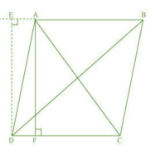
In parallelogram ABCD, AF and DE are altitudes drawn on DC and produced BA.
In $\triangle$ DEA, by Pythagoras theorem
$DA^2=DE^2+EA^2.......................1$
In $\triangle$ DEB, by Pythagoras theorem
$DB^2=DE^2+EB^2$
$DB^2=DE^2+(EA+AB)^2$
$DB^2=DE^2+(EA)^2+(AB)^2+2.EA.AB$
$DB^2=DA^2+(AB)^2+2.EA.AB$ ....................................2
In $\triangle$ ADF, by Pythagoras theorem
$DA^2=AF^2+FD^2$
In $\triangle$ AFC, by Pythagoras theorem
$AC^2=AF^2+FC^2=AF^2+(DC-FD)^2$
$\Rightarrow AC^2=AF^2+(DC)^2+(FD)^2-2.DC.FD$
$\Rightarrow AC^2=(AF^2+FD^2)+(DC)^2-2.DC.FD$
$\Rightarrow AC^2=AD^2+(DC)^2-2.DC.FD.......................3$
Since ABCD is a parallelogram.
SO, AB=CD and BC=AD
In $\triangle DEA\, and\, \triangle ADF,$
$\angle DEA=\angle AFD\, \, \, \, \, \, \, (each 90 ^\circ)$
$\angle DAE=\angle ADF$ (AE||DF)
AD=AD (common)
$\triangle DEA\, \cong \, \triangle ADF,$ (ASA rule)
$\Rightarrow EA=DF.......................6$
Adding 2 and, we get
$DA^2+AB^2+2.EA.AB+AD^2+DC^2-2.DC.FD=DB^2+AC^2$ $\Rightarrow DA^2+AB^2+AD^2+DC^2+2.EA.AB-2.DC.FD=DB^2+AC^2$
$\Rightarrow BC^2+AB^2+AD^2+2.EA.AB-2.AB.EA=DB^2+AC^2$ (From 4 and 6)
$\Rightarrow BC^2+AB^2+CD^2=DB^2+AC^2$ \
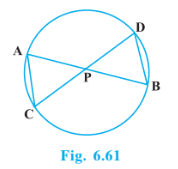
Answer:
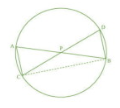
Join BC
In $\triangle APC\, \, and\, \triangle DPB,$
$\angle APC\, \, = \angle DPB$ ( vertically opposite angle)
$\angle CAP\, \, = \angle BDP$ (Angles in the same segment)
$\triangle APC\, \, \sim \triangle DPB$ (By AA)
Q7 (2) In Fig. 6.61, two chords AB and CD intersect each other at point P. Prove that : $AP . PB = CP . DP$
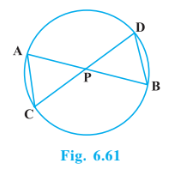
Answer:
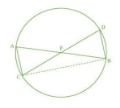
Join BC
In $\triangle APC\, \, and\, \triangle DPB,$
$\angle APC\, \, = \angle DPB$ ( vertically opposite angle)
$\angle CAP\, \, = \angle BDP$ (Angles in the same segment)
$\triangle APC\, \, \sim \triangle DPB$ (By AA)
$\frac{AP}{DP}=\frac{PC}{PB}=\frac{CA}{BD}$ (Corresponding sides of similar triangles are proportional)
$\Rightarrow \frac{AP}{DP}=\frac{PC}{PB}$
$\Rightarrow AP.PB=PC.DP$
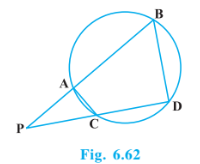
Answer:
In $\Delta PAC \,and \,\Delta PDB,$
$\angle P=\angle P$ (Common)
$\angle PAC=\angle PDB$ (Exterior angle of a cyclic quadrilateral is equal to opposite interior angle)
So, $\Delta PAC \sim \Delta PDB$ ( By AA rule)
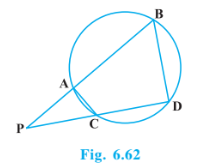
Answer:
In $\Delta PAC \,and \,\Delta PDB,$
$\angle P=\angle P$ (Common)
$\angle PAC=\angle PDB$ (Exterior angle of a cyclic quadrilateral is equal to opposite interior angle)
So, $\Delta PAC \sim \Delta PDB$ ( By AA rule)
24440 $\frac{AP}{DP}=\frac{PC}{PB}=\frac{CA}{BD}$ (Corresponding sides of similar triangles are proportional)
$\Rightarrow \frac{AP}{DP}=\frac{PC}{PB}$
$\Rightarrow AP.PB=PC.DP$
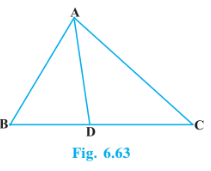
Answer:
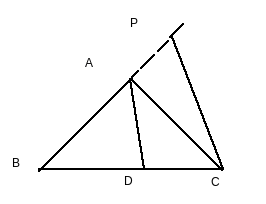
Produce BA to P, such that AP=AC and join P to C.
$\frac{BD }{CD} = \frac{AB}{AC}$ (Given )
$\Rightarrow \frac{BD }{CD} = \frac{AP}{AC}$
Using converse of Thales theorem,
AD||PC $\Rightarrow \angle BAD=\angle APC............1$ (Corresponding angles)
$\Rightarrow \angle DAC=\angle ACP............2$ (Alternate angles)
By construction,
AP=AC
$\Rightarrow \angle APC=\angle ACP............3$
From equation 1,2,3, we get
$\Rightarrow \angle BAD=\angle APC$
Thus, AD bisects angle BAC.

Answer:
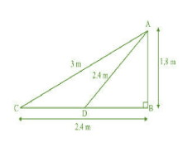
Let AB = 1.8 m
BC is a horizontal distance between fly to the tip of the rod.
Then, the length of the string is AC.
In $\triangle$ ABC, using Pythagoras theorem
$AC^2=AB^2+BC^2$
$\Rightarrow AC^2=(1.8)^2+(2.4)^2$
$\Rightarrow AC^2=3.24+5.76$
$\Rightarrow AC^2=9.00$
$\Rightarrow AC=3 m$
Hence, the length of the string which is out is 3m.
If she pulls in the string at the rate of 5cm/s, then the distance travelled by fly in 12 seconds.
= $12\times 5=60cm=0.6m$
Let D be the position of fly after 12 seconds.
Hence, AD is the length of the string that is out after 12 seconds.
Length of string pulled in by nazim=AD=AC-12
=3-0.6=2.4 m
In $\triangle$ ADB,
$AB^2+BD^2=AD^2$
$\Rightarrow (1.8)^2+BD^2=(2.4)^2$
$\Rightarrow BD^2=5.76-3.24=2.52 m^2$
$\Rightarrow BD=1.587 m$
Horizontal distance travelled by fly = BD+1.2 m
=1.587+1.2=2.787 m
= 2.79 m
More About NCERT Solutions for Class 10 Maths Exercise 6.6
Class 10 Maths chapter 6 exercise 6: The questions in exercise 6.6 Class 10 Maths consist of many types of questions covering different types of theorems and formulas. Firstly we have a question in which we have to prove the left-hand side argument and right-hand side argument NCERT solutions for Class 10 Maths exercise 6.6 also have questions. Exercise 6.6 Class 10 Maths covers all types of questions that can be formed on the similarity of triangles. Students can also access Triangles Class 10 Notes here and use them for quickly revision of the concepts related to Triangles.
Benefits of NCERT Solutions for Class 10 Maths Exercise 6.6
- Class 10 Maths chapter 6 exercise 6.6 broadly covers all kinds of questions that can be formed on the mixed concept of the triangle and gives a great amount of practice to conquer some amount of expertise in the triangle.
- NCERT Class 10 Maths chapter 6 exercise 6.6, will be helpful in JEE Main (joint entrance exam) as triangles are a major part of some chapters.
- Exercise 6.6 Class 10 Maths, is based on all the theorem, exercises and topics which have been covered in the whole chapter
Also, See:
NCERT Solutions of Class 10 Subject Wise
Subject Wise NCERT Exemplar Solutions
Frequently Asked Questions (FAQs)
similarity of triangle
Criteria for Similarity of Triangles
Areas of Similar Triangles
Pythagoras Theorem
If the respective angles are congruent and the corresponding sides are proportional, two triangles are said to be similar.
NCERT solutions for Class 10 Maths exercise 6.6 is different from other exercises as all other exercises are based on a single concept and theorem they are base building exercises but Class 10 Maths chapter 6 exercise 6.6 is based on all the concepts.
Yes Class 10 Maths chapter 6 exercise 6.6 because it have questions which have mix concepts
There are 13 main theorems are there which we require to solve NCERT solutions for Class 10 Maths 1 exercise 6.6
There are ten questions in exercise 6.6 Class 10 Maths question
There are two types of questions in exercise 6.6 Class 10 Maths question one type is there in which we have to proof LHS and RHS these contains uses of theorem and other is real life application of triangle
Questions related to CBSE Class 10th
On Question asked by student community
Good Morning, candidate,
The question papers will be available soon at the link attached herewith. You can keep an eye on the website of careers360. it will provide you perfect pattern of question papers, which will improve your writing skills and practice learning.
https://school.careers360.com/articles/cbse-sahodaya-class-10-pre-board- question-paper-2025-26
Thank you.
Hello,
You can download subject wise CBSE Sahodaya Class 10 Pre-Board Question Paper 2025-26 for Round 1 & Round 2 from this link : CBSE Sahodaya Class 10 Pre-Board Question Paper 2025-26
Hope it helps !
Hello there,
Solving question papers is one of the best method of preparation. It gives you proper idea about the exam pattern and important topics to cover.
Here is the link attached from the official website of Careers360 which will provide you with the CBSE Sahodaya question papers. Hope it helps!
https://school.careers360.com/articles/sahodaya-question-paper-2025
thank you!
The CBSE Class 10 Hindi Question Paper Blueprint (Marking Pattern) for the 2025-2026 Board Exam is divided into four main sections, with a total of 80 marks for the written exam. The structure is slightly different for Hindi Course A and Hindi Course B.You can download the official Sample Question Paper (SQP) and its Marking Scheme for both Hindi Course A and Course B here: https://school.careers360.com/boards/cbse/cbse-class-10-hindi-sample-papers-2025-26
The CBSE Sahodaya Question Papers for Class 10 (2025-26) are not released centrally by the board as a single PDF.
Here is the essential information you need:
-
Local Release: The papers are designed and released by the individual Sahodaya School Clusters (groups of CBSE schools) just before or during the pre-board exam dates (typically held in December and January). Therefore, you must check your local cluster's portal or directly with your school administration.
-
Best Practice: The official model papers, based on the full 2026 syllabus, are the most reliable tool for practice. These accurately reflect the structure, format, and competency-based questions used in the Sahodaya exams.
You can download the latest CBSE Class 10 Model Papers to simulate the Sahodaya tests here: https://school.careers360.com/articles/sahodaya-question-paper-2025 . Focus on that pattern
Applications for Admissions are open.
As per latest syllabus. Physics formulas, equations, & laws of class 11 & 12th chapters
JEE Main Important Chemistry formulas
Get nowAs per latest syllabus. Chemistry formulas, equations, & laws of class 11 & 12th chapters
JEE Main high scoring chapters and topics
Get nowAs per latest 2024 syllabus. Study 40% syllabus and score upto 100% marks in JEE
JEE Main Important Mathematics Formulas
Get nowAs per latest syllabus. Maths formulas, equations, & theorems of class 11 & 12th chapters
